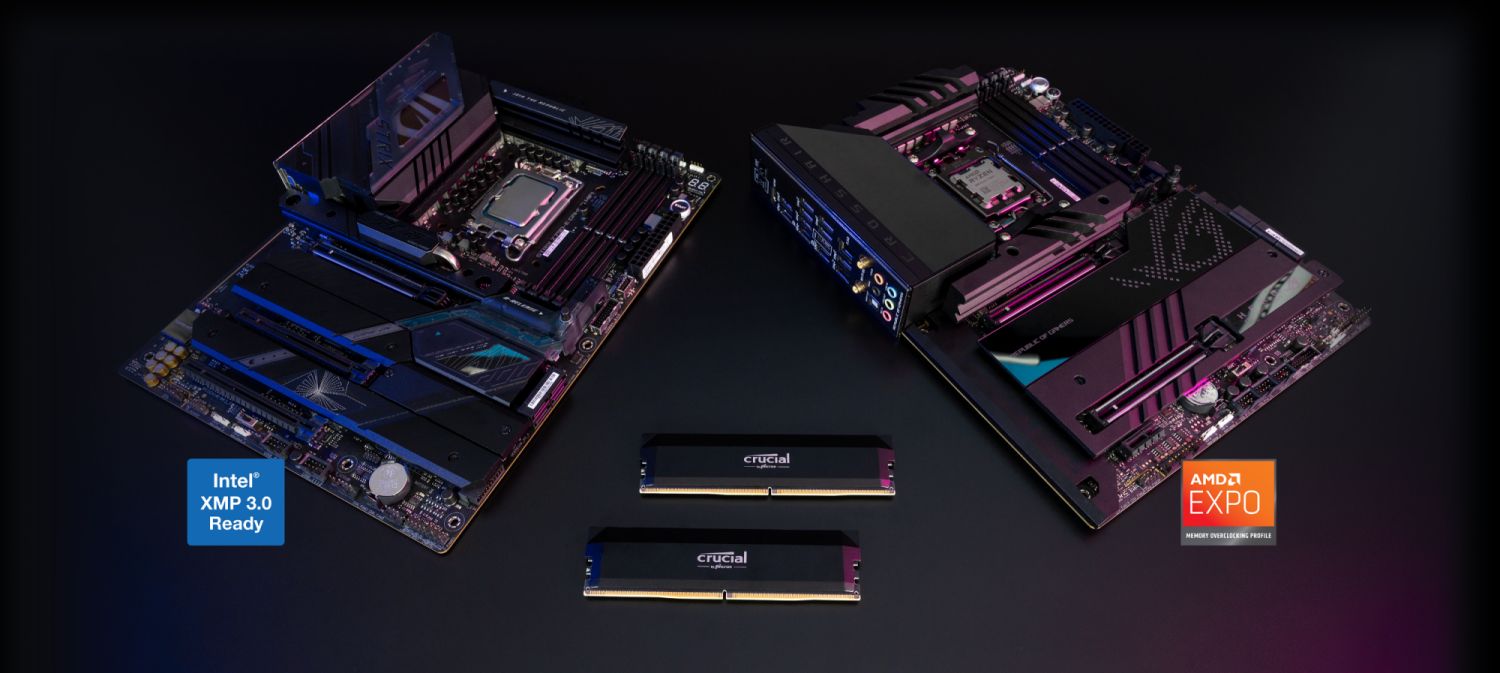Crucial ® DDR5 Pro Memory:
Overclocking Edition

Overclocking DDR5 Pro memory
Push performance to the next level with the blazing speed and massive bandwidth
of Crucial ® DDR5 Pro Memory: Overclocking Edition. Mobilize the
power of low latency to beat the clock and fuel your next win instead of
worrying about performance bottlenecks. Our powerful overclocking DDR5 Pro
memory supports next-gen multi-core CPUs and features Intel ® XMP 3.0
and AMD EXPO ™ support 1 on every module.
Cool look and feel
Our overclocking DDR5 Pro memory features an aluminum heat
spreader with a unique, origami-based design that is both
cool to the touch and an aesthetic win for any rig.
Accelerated performance
for more wins
Since every millisecond gained in fast-paced gameplay means the
difference between winning and losing, seize the advantage with
25% lower latency 4 for higher frame rates per
second.
Emiliano "Durtho" | esports CRL Rookie of the
Year
- Crucial DDR5 desktop memory modules (UDIMMs) can reach rated speeds with Intel XMP 3.0 or AMD EXPO ™ turned on in the UEFI/BIOS settings. Applicable for all Crucial DDR5 desktop memory (UDIMM) modules except Crucial DDR5-4800 desktop memory, which supports only Intel ® XMP 3.0. Based on published competitor specs for DDR5 memory as of August 2023. Altering clock frequency or voltage beyond rated speeds of 6,000MT/s and timing of 36-38-38-80 at 1.35V may result in damage to computer components and will void your Crucial warranty. Micron disclaims all liability for such damage.
- Crucial DDR5 Pro Memory modules (UDIMMs) can only be installed in desktops/workstations built to support DDR5 DRAM, such as 12th and 13th Gen Intel ® Core ™ and AMD Ryzen™ 7000 Series desktop processors.
- DDR5 data rate of 6,000MT/s transfers 1.88x the DDR4 data rate of 3,200MT/s.
- Comparing the true memory latency of Crucial Pro DRAM Overclocking Edition of 12ns for 6000MT/s CL36 to the true memory latency of Crucial Pro DRAM Plug-and-Play edition of 16ns for 6000MT/s CL48. 12ns is 25% lower than 16ns of true memory latency.
- Under memory-intensive workloads, DDR5 can deliver up to 2x the bandwidth, per an internal simulation of dual ranked x8 modules in client platforms.
- DDR5 modules (DIMMs) introduce voltage regulation on the module through a power management integrated circuit (PMIC), which enables better power regulation and reduces the scope of DRAM power delivery network (PDN) management on the motherboard for increased efficiency.
- On-die ECC (ODECC) is a feature of the DDR5 component specification and should not be confused with the module-level ECC features on server and workstation RDIMMs, LRDIMMs, ECC UDIMMs and ECC. Crucial DDR5 Memory includes ODECC but does not include the additional components necessary for system level ECC.
- Densities are defined by JEDEC for the life of the DDR5 generation of memory.
- Limited lifetime warranty valid everywhere except Austria, Belgium, France
and Germany, where warranty is valid for ten years from the date of
purchase. DRAM components and modules are rated for 6,000MT/s 36-38-38-80 at
1.35V. Altering the module’s clock frequency, speed, timings or voltage
beyond its specifications may damage system components and will void its
warranty. Micron disclaims all liability for damage caused by overclocking
beyond 6,000MT/s 36-38-38-80 at 1.35V. Please check your CPU and motherboard
manuals for their warranty information when overclocking.




